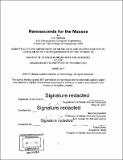Nanoseconds for the masses
Author(s)
VanWyk, Eric (Eric Judson)
DownloadFull printable version (8.208Mb)
Other Contributors
Program in Media Arts and Sciences (Massachusetts Institute of Technology)
Advisor
Neil Gershenfeld.
Terms of use
Metadata
Show full item recordAbstract
High precision voltage measurement has become a hidden part of our daily lives. Our phones, our wearables, and even our household appliances now include precision measurement capability that rivals what was once only available in laboratory grade test equipment. Converters with 6 digits of resolution and nanovolt noise floors cost less than a dollar and fit into our watches. In contrast, measurement of fast phenomena remains out of our daily reach, as it requires equipment too expensive and too unwieldy to be found outside the hands of specialists. Commoditization of sub-nanosecond measurement would improve our ability to process the information from spectral sensors, which in turn would impact portable medical diagnostics, environmental monitoring, and the healthy maintenance of the infrastructure we rely on. Here a novel measurement architecture is presented that enables cost effective measurement of these sub-nanosecond phenomena, and is easily integrated into existing digital processes. It is built on the same founding premises that the sigma delta architecture uses to dominate low cost precision measurement: 1) Precise measurement with imprecise components 2) Digital logic replacements for analog components 3) Trade time for accuracy A prototype unit constructed from existing digital communication components is shown to achieve 11 equivalent bits of resolution at 3GHz of analog bandwidth, with repeatability better than 1 millivolt and 3 picoseconds. Timing uncertainty is shown to be better than 1 picosecond. Several use cases are presented: Differential dielectric spectroscopy, LIDAR, and USB 3 SuperSpeed channel sounding.
Description
Thesis: S.M., Massachusetts Institute of Technology, School of Architecture and Planning, Program in Media Arts and Sciences, 2017. Cataloged from PDF version of thesis. Includes bibliographical references (pages 46-49).
Date issued
2017Department
Program in Media Arts and Sciences (Massachusetts Institute of Technology)Publisher
Massachusetts Institute of Technology
Keywords
Program in Media Arts and Sciences ()